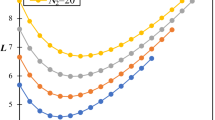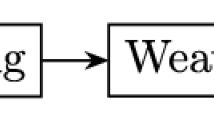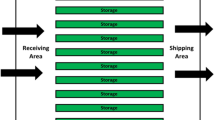Abstract
In, the recent scenario, the utilization of robots in different areas such as packaging, loading/unloading, transportation, and especially assembly lines enhance the productivity of production systems. The increasing interest of customers in customized products and full fill customer demand within time is a challenge for the companies to balance and configure their robotic assembly line more efficient and effective than ever before. Robotic two-sided assembly line balancing problem (RTALBP) generally occurs in plants producing high volume, large-sized products, where there is a process of installing more than one robot on every single station of the assembly line for manufacturing the product. The main aim of this paper is to develop a new mathematical model with the objective of workload maximization on each workstation that directly minimizes the number of workstations when cycle time is fixed. Robotic two-sided assembly line balancing problem is well known NP-hard problem that’s why an exact solution approach is proposed to solve the problem. In this paper, real-life assembly line balancing based production case study data is collected, and a proposed mathematical model is applied to get a feasible solution. Benchmark problem and production case study problem is solved using a branch and bound algorithm on Lingo 16 solver. Computational results indicated proper allocation of robots and reduce the number of robots which indirectly increased efficiency and save cost and space for assembling the products.






Similar content being viewed by others
References
Aghajani M, Ghodsi R, Javadi B (2014) Balancing of robotic mixed-model two-sided assembly line with robot setup times. Int J Adv Manuf Technol 74(5–8):1005–1016
Battaïa O, Dolgui A (2013) A taxonomy of line balancing problems and their solution approaches. Int J Prod Econ 142(2):259–277
Baybars I (1986) A survey of exact algorithms for the simple assembly line balancing problem. Manage Sci 32(8):909–932
Becker C, Scholl A (2006) A survey on problems and methods in generalized assembly line balancing. Eur J Oper Res 168(3):694–715
Borba L, Ritt M, Miralles C (2018) Exact and heuristic methods for solving the robotic assembly line balancing problem. Eur J Oper Res 270(1):146–156
Boysen N, Fliedner M, Scholl A (2008) Assembly line balancing: Which model to use when? Int J Prod Econ 111(2):509–528
Chutima P (2020) A comprehensive review of robotic assembly line balancing problem. J Intell Manuf 31(6):1–34
Çil ZA, Mete S, Özceylan E, Ağpak K (2017a) A beam search approach for solving type II robotic parallel assembly line balancing problem. Appl Soft Comput 61:129–138
Çil ZA, Mete S, Ağpak K (2017b) Analysis of the type II robotic mixed-model assembly line balancing problem. Eng Optim 49(6):990–1009
Daoud S, Amodeo L, Yalaoui F, Chehade H, Duperray P (2012) New mathematical model to solve robotic assembly lines balancing. IFAC Proc Vol 45(6):1353–1358
Erel E, Sarin SC (1998) A survey of the assembly line balancing procedures. Prod Planning Control 9(5):414–434
Gao J, Sun L, Wang L, Gen M (2009) An efficient approach for type II robotic assembly line balancing problems. Comput Ind Eng 56(3):1065–1080
Janardhanan MN, Li Z, Bocewicz G, Banaszak Z, Nielsen P (2019) Metaheuristic algorithms for balancing robotic assembly lines with sequence-dependent robot setup times. Appl Math Model 65:256–270
Kammer Christensen M, Janardhanan MN, Nielsen P (2017) Heuristics for solving a multi-model robotic assembly line balancing problem. Prod Manuf Res 5(1):410–424
Kucukkoc I, Zhang DZ (2015) A mathematical model and genetic algorithm-based approach for parallel two-sided assembly line balancing problem. Prod Planning Control 26(11):874–894
Levitin G, Rubinovitz J, Shnits B (2006) A genetic algorithm for robotic assembly line balancing. Eur J Oper Res 168(3):811–825
Li Z, Tang Q, Zhang L (2016a) Minimizing energy consumption and cycle time in two-sided robotic assembly line systems using restarted simulated annealing algorithm. J Clean Prod 135:508–522
Li Z, Janardhanan MN, Tang Q, Nielsen P (2016b) Co-evolutionary particle swarm optimization algorithm for two-sided robotic assembly line balancing problem. Adv Mech Eng 8(9):168–184
Li Z, Kucukkoc I, Nilakantan JM (2017) Comprehensive review and evaluation of heuristics and meta-heuristics for two-sided assembly line balancing problem. Comput Oper Res 84:146–161
Li Z, Janardhanan MN, Nielsen P, Tang Q (2018a) Mathematical models and simulated annealing algorithms for the robotic assembly line balancing problem. Assem Autom 38(4):420–436
Li Z, Dey N, Ashour AS, Tang Q (2018b) Discrete cuckoo search algorithms for two-sided robotic assembly line balancing problem. Neural Comput Appl 30(9):2685–2696
Li Z, Janardhanan MN, Tang Q, Ponnambalam SG (2019) Model and metaheuristics for robotic two-sided assembly line balancing problems with setup times. Swarm Evolut Comput 50:100567
Li Z, Janardhanan MN, Ponnambalam SG (2020) Cost-oriented robotic assembly line balancing problem with setup times: multi-objective algorithms. J Intell Manuf 32:989–1007
Nilakantan JM, Ponnambalam SG (2016) Robotic U-shaped assembly line balancing using particle swarm optimization. Eng Optim 48(2):231–252
Nilakantan JM, Huang GQ, Ponnambalam SG (2015a) An investigation on minimizing cycle time and total energy consumption in robotic assembly line systems. J Clean Prod 90:311–325
Nilakantan JM, Ponnambalam SG, Jawahar N, Kanagaraj G (2015b) Bio-inspired search algorithms to solve robotic assembly line balancing problems. Neural Comput Appl 26(6):1379–1393
Nilakantan MJ, Ponnambalam SG, Jawahar N, Owen DRJ (2016) Design of energy efficient RAL system using evolutionary algorithms. Eng Comput 33(2):580–602
Nilakantan JM, Nielsen I, Ponnambalam SG, Venkataramanaiah S (2017a) Differential evolution algorithm for solving RALB problem using cost-and time-based models. Int J Adv Manuf Technol 89(1–4):311–332
Nilakantan JM, Li Z, Tang Q, Nielsen P (2017b) Multi-objective co-operative co-evolutionary algorithm for minimizing carbon footprint and maximizing line efficiency in robotic assembly line systems. J Clean Prod 156:124–136
Pereira J, Ritt M, Vásquez ÓC (2018) A memetic algorithm for the cost-oriented robotic assembly line balancing problem. Comput Oper Res 99:249–261
Rabbani M, Mousavi Z, Farrokhi-Asl H (2016) Multi-objective metaheuristics for solving a type II robotic mixed-model assembly line balancing problem. J Ind Prod Eng 33(7):472–484
Rubinovitz J, Bukchin J, Lenz E (1993) RALB–A heuristic algorithm for design and balancing of robotic assembly lines. CIRP Ann 42(1):497–500
Scholl A, Becker C (2006) State-of-the-art exact and heuristic solution procedures for simple assembly line balancing. Eur J Oper Res 168(3):666–693
Scholl A, Voß S (1997) Simple assembly line balancing—Heuristic approaches. J Heuristics 2(3):217–244
Sivasankaran P, Shahabudeen P (2014) Literature review of assembly line balancing problems. Int J Adv Manuf Technol 73(9–12):1665–1694
Yadav A, Agrawal S (2019, May) Minimize idle time in two sided assembly line balancing using exact search approach. In: Proceedings of the 2019 international conference on management science and industrial engineering, pp 220–227.
Yoosefelahi A, Aminnayeri M, Mosadegh H, Ardakani HD (2012) Type II robotic assembly line balancing problem: An evolution strategies algorithm for a multi-objective model. J Manuf Syst 31(2):139–151
Zhang Z, Tang Q, Zhang L (2019) Mathematical model and grey wolf optimization for low-carbon and low-noise U-shaped robotic assembly line balancing problem. J Clean Prod 215:744–756
Zhou B, Wu Q (2018) A novel optimal method of robotic weld assembly line balancing problems with changeover times: a case study. Assem Autom 38(4):376–386
Zhou B, Wu Q (2019) An improved immune clonal selection algorithm for bi-objective robotic assemble line balancing problems considering time and space constraints. Eng Comput 36(6):1868–1892
Acknowledgements
This research was partially supported by ABC production plant for providing help in the collection of data and valuable information.
Funding
The author has not found any funds (Financial Support) for this work.
Author information
Authors and Affiliations
Corresponding author
Ethics declarations
Conflict of interest
There is no conflict of interest.
Additional information
Publisher's Note
Springer Nature remains neutral with regard to jurisdictional claims in published maps and institutional affiliations.
Rights and permissions
About this article
Cite this article
Yadav, A., Agrawal, S. Mathematical model for robotic two-sided assembly line balancing problem with zoning constraints. Int J Syst Assur Eng Manag 13, 395–408 (2022). https://doi.org/10.1007/s13198-021-01284-8
Received:
Revised:
Accepted:
Published:
Issue Date:
DOI: https://doi.org/10.1007/s13198-021-01284-8




